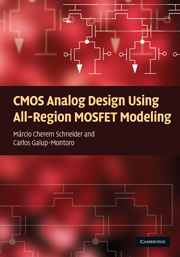Book contents
- Frontmatter
- Contents
- Preface
- 1 Introduction to analog CMOS design
- 2 Advanced MOS transistor modeling
- 3 CMOS technology, components, and layout techniques
- 4 Temporal and spatial fluctuations in MOSFETs
- 5 Current mirrors
- 6 Current sources and voltage references
- 7 Basic gain stages
- 8 Operational amplifiers
- 9 Fundamentals of integrated continuous-time filters
- 10 Fundamentals of sampled-data circuits
- 11 Overview of MOSFET models and parameter extraction for design
- Index
- References
10 - Fundamentals of sampled-data circuits
Published online by Cambridge University Press: 17 December 2010
- Frontmatter
- Contents
- Preface
- 1 Introduction to analog CMOS design
- 2 Advanced MOS transistor modeling
- 3 CMOS technology, components, and layout techniques
- 4 Temporal and spatial fluctuations in MOSFETs
- 5 Current mirrors
- 6 Current sources and voltage references
- 7 Basic gain stages
- 8 Operational amplifiers
- 9 Fundamentals of integrated continuous-time filters
- 10 Fundamentals of sampled-data circuits
- 11 Overview of MOSFET models and parameter extraction for design
- Index
- References
Summary
The first part of this chapter is dedicated to the MOS sample-and-hold circuit (S/H). The main physical limitations of the MOS S/H, namely switch on-resistance, thermal noise, and switch charge injection, are reviewed. Distortion produced by the non-linear switch resistance is modeled and some circuit-linearization techniques for MOS switches are introduced as well as low-voltage circuit techniques. Finally, clock-jitter effects on the MOS S/H are modeled and these effects in analog-to-digital converters are commented on. The second part of the chapter presents the basics of switched-capacitor (SC) circuits. Parasitic insensitive integrators and second-order filters are reviewed. Amplifier specifications for SC circuits are detailed, as well as some circuit techniques to reduce the effects of op-amp imperfections. The important topic of SC circuits fully compatible with digital MOS technology ends the section on SC circuits. The last part of the chapter briefly introduces alternative switched circuits, specifically switched-MOSFET and switched-current filters.
MOS sample-and-hold circuits
Sample-and-hold (or track-and-hold) circuits are ubiquitous in signal-processing circuits. They are used at the front end of analog-to-digital (A/D) converters and at the back end of digital-to-analog (D/A) converters. The signal-to-noise ratio of an A/D converter is usually limited by the performance of the sample-and-hold block. Furthermore, precision analog integrated circuits are mostly implemented by sampled-data circuits in which the basic building block is the S/H.
Sample-and-hold basics
An ideal S/H is depicted in Figure 10.1. During the sampling mode, the switch S is on and the output voltage tracks the input voltage.
Information
- Type
- Chapter
- Information
- CMOS Analog Design Using All-Region MOSFET Modeling , pp. 404 - 451Publisher: Cambridge University PressPrint publication year: 2010
